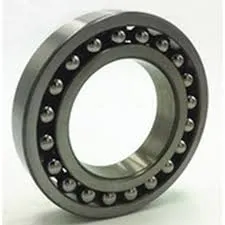
ធ្នូ . 17, 2024 01:44 Back to list
what are angular contact bearings
Understanding Angular Contact Bearings
Angular contact bearings are a class of rolling-element bearings that are designed to accommodate both radial and axial loads. Unlike standard radial bearings, which can only support radial loads, angular contact bearings can handle significant axial loads in one direction due to their unique design. This feature makes them particularly useful in various applications, including electric motors, automotive components, and machine tool spindles.
Design and Construction
The fundamental design of angular contact bearings consists of two rings (the inner and outer races) and a set of rolling elements, typically balls or rollers, that are situated between the two rings. The key distinguishing feature of angular contact bearings is the angle at which the rolling elements are positioned. This angle—measured from the radial line—is typically between 15 and 40 degrees, with common angles being 15, 25, or 30 degrees.
The design allows the bearing to support loads that are applied at an angle, enabling it to manage both radial and axial forces. The axial load capacity increases with the angle of contact; therefore, a larger contact angle provides more ability to withstand axial loads. This is crucial in applications where both types of loads are present.
Types of Angular Contact Bearings
Angular contact bearings are available in various configurations based on the specific requirements of the application. The most common types include
1. Single-Row Angular Contact Bearings These are designed to carry loads in one direction. If axial loads act in both directions, they must be used in pairs one bearing facing one direction and another facing the opposite.
2. Double-Row Angular Contact Bearings These bearings can support axial loads in both directions and can handle higher radial loads compared to single-row designs. They are often used in applications where space is limited.
what are angular contact bearings

4. Adjustable Angular Contact Bearings These bearings can be adjusted for preload, which can enhance their performance and longevity in specific environments by ensuring a proper fit between components.
Advantages of Angular Contact Bearings
1. High Load Capacity The ability to handle both axial and radial loads makes angular contact bearings a premium choice for high-load applications.
2. Improved Rigidity Due to their design and construction, these bearings provide superior support and stability, which leads to enhanced performance in dynamic applications.
3. Operational Efficiency Angular contact bearings typically operate with lower friction than standard bearings, leading to reduced heat generation and prolonged service life.
4. Versatility They are suitable for applications across various industries, from aerospace to manufacturing, thanks to their adaptability to different load conditions.
Applications
Angular contact bearings are found in many critical applications. In the automotive industry, they are used in wheel hubs, gearboxes, and electric motors, where they manage heavy load requirements and rotate at high speeds. In machine tools, they help maintain precision and stability in spindle operations, which is vital for manufacturing accuracy. Additionally, their use in robotics, aerospace, and electric generators showcases their versatility.
Conclusion
Angular contact bearings are an essential component in various mechanical systems, providing robust solutions for load balancing in multiple directions. With their unique design features, they enable enhanced performance and longevity in the most demanding applications. Understanding the advantages and types of angular contact bearings can help engineers and manufacturers select the right bearing for their specific needs, ensuring reliability and efficiency in their operations. As technology advances, the demand for these specialized bearings will likely continue to grow, making them a critical area of focus within engineering and manufacturing sectors.
Latest news
-
The Future of Deep Groove Ball Bearings For Extreme Applications
NewsJul.31,2025
-
Self-Lubricating Bearings: The Future of Agricultural Machinery Efficiency
NewsJul.31,2025
-
Nanotechnology in Ball Bearing Machines: The Future of Friction Reduction
NewsJul.31,2025
-
How Deep Groove Ball Bearings Are Tailored for Different Uses
NewsJul.31,2025
-
Energy-Efficient Machinery Bearings: Reducing Power Consumption in Large-Scale Ball Mills
NewsJul.31,2025
-
Deep Groove vs. Angular Contact: Which Ball Bearing Wins in High-Speed Applications
NewsJul.31,2025
